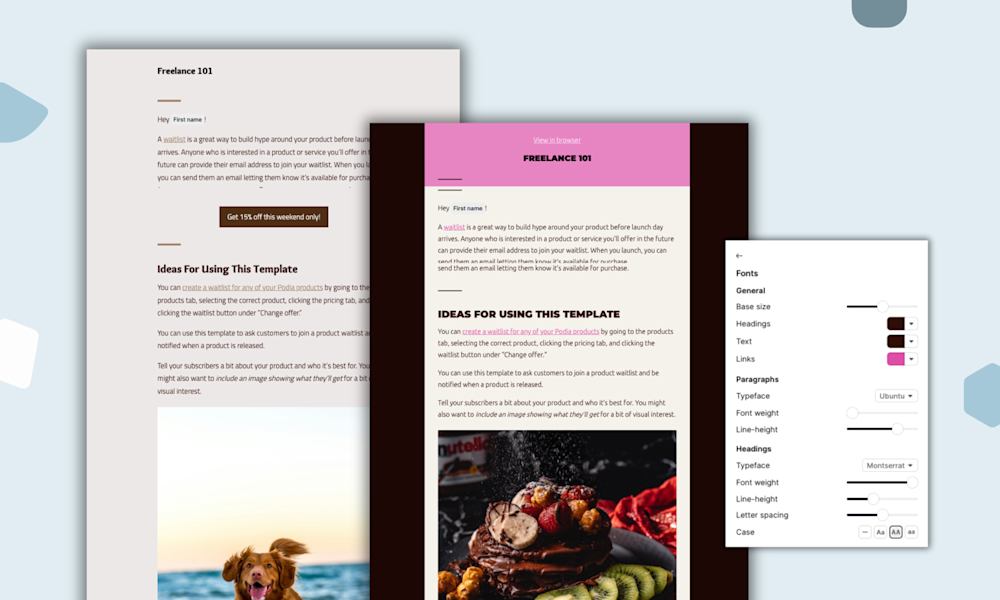Have you ever worked up the courage to give someone your number, then waited for days (or even weeks) to hear from them?
If you have, I feel your pain.
If you haven’t, trust me: It doesn’t feel great. And when you’re building a business, you definitely don’t want your potential customers to feel that way.
That’s why welcome emails are a vital part of your email marketing strategy.
When someone signs up for your email list, they’re trusting you with their contact information. Don’t leave them hanging — reach out and welcome them ASAP.
Today, we’re sharing six tips for crafting a welcome email your new subscribers will love, including eight of the best welcome email examples from Podia creators.
But first, what is a welcome email? And why should you send one?
What is a welcome email (and why should you send one)?
A welcome email is the first email new contacts receive after signing up for your email list. Welcome emails are often automated, so subscribers receive them within just a few minutes of signing up.
Why should you create and send a welcome email when someone subscribes to your email newsletter?
First and foremost, customers expect you to. 74% of consumers expect a welcome email as soon as they subscribe. And given that new leads are most engaged within 48 hours of subscribing, the sooner you reach out, the better.
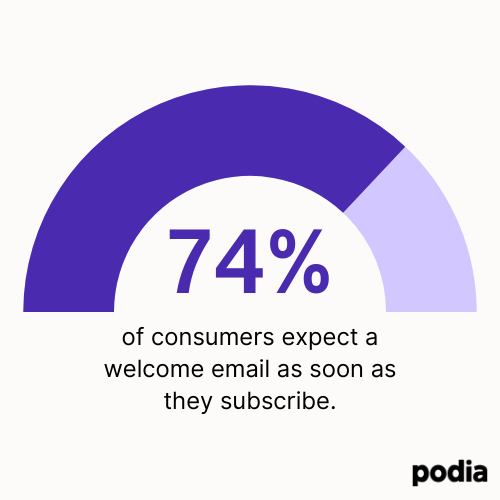
Welcome emails also perform better and see higher engagement than typical marketing emails:
-
Welcome emails can have up to a 91.43% open rate.
-
On average, welcome emails have 4x the open rate and 5x the click-through rate (CTR) of a standard email campaign.
-
Welcome emails generate an average of 320% more revenue per email than other promotional emails.
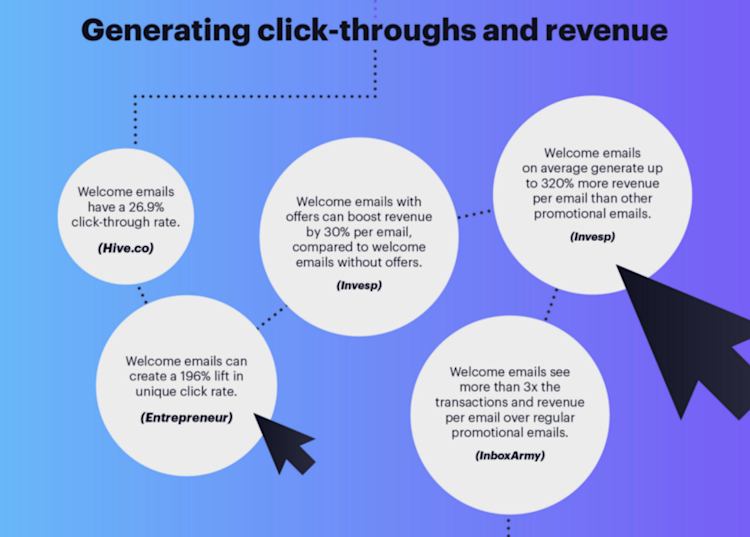
Statistics aside, your welcome email is your opportunity to make a fantastic first impression, especially for subscribers interacting with your brand for the first time.
They’ve just trusted you with valuable info: Their email address. This is your chance to show them that they made the right choice.
Email marketing expert Val Geisler put it best with this analogy of a dinner party:
“You wouldn’t greet someone at your house by turning your back to them, letting them fumble with their bags and shoes while trying to figure out where to put their coat, and you certainly wouldn’t start shoving the main course in their face before they’ve even walked in the door. A dinner party requires a warm welcome, a friendly greeting, and lots of pacing. This email is the beginning of a beautiful relationship… so treat it like one.”
So, how do you craft that warm welcome and friendly greeting? In our next section, we’ve got six pro tips to help you do exactly that.
6 tips for crafting an excellent welcome email
1. Write an attention-grabbing subject line
Over 300 billion emails are sent every day. Make your welcome email stand out in a crowded inbox with a subject line your audience can’t resist.
When it comes to email marketing, subject lines do a lot of heavy lifting. 47% of email recipients open emails based on the subject line alone, while a staggering 69% of email recipients report email as spam judging solely by the subject line.
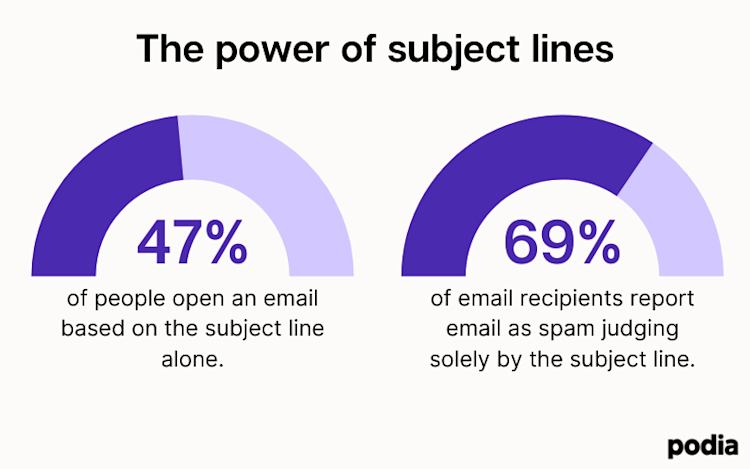
How can you tell if your welcome email subject line is working? Take a look at one of the most essential email metrics: your open rate.
The open rate tracks how many email subscribers open a given email. To calculate an email’s open rate, divide the number of unique opens of a campaign email by the total number of emails sent.
In 2021, the average open rate is 19.84% across industries. If your open rate isn’t up to par, don’t worry. You can raise it by following some of these subject line best practices:
-
Avoid using the word “newsletter”. It can decrease your open rate by 18.7%.
-
Shoot for a length of 6–10 words. Use this tool to preview your subject line.
-
If it fits your brand, add an emoji or two. It can lead to a 56% higher open rate than a subject line without emoji.
-
Subject lines that include a number can earn a 1.3% higher open rate than average emails.
-
Personalized messaging drives the highest open rates.
(Check out this article for more email subject line tips and formulas.)
When I write a marketing email, I always run my subject line through the Send Check It tool. This email subject line tester scores your subject line based on several factors and gives suggestions to help you get more opens.
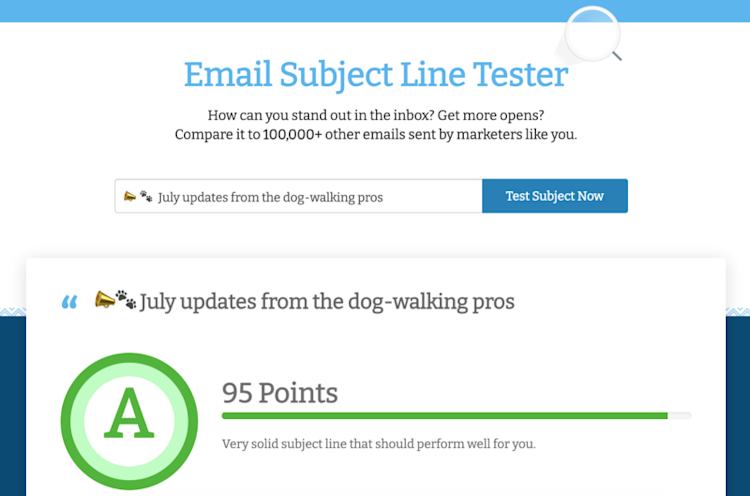
You can also A/B test different subject lines to find what makes your audience want to open your emails.
A/B testing, also called split testing, refers to testing two different variables — in this case, subject lines — to see which one performs better. 70% of professional marketers report that they test subject lines and messaging most frequently.
Once you have an attention-grabbing subject line, it’s time to move on to the body of your email.
2. Make new subscribers feel welcome
At its core, your welcome email should do exactly what the name implies: Make your new subscribers feel welcome. Thank them for signing up for your newsletter and let them know how excited you are that they’re a part of your community.
It may sound like basic manners, but a little appreciation can go a long way. 51% of customers claim companies are falling short of their customer experience expectations, and 54% of them don’t believe that companies have their best interests in mind.
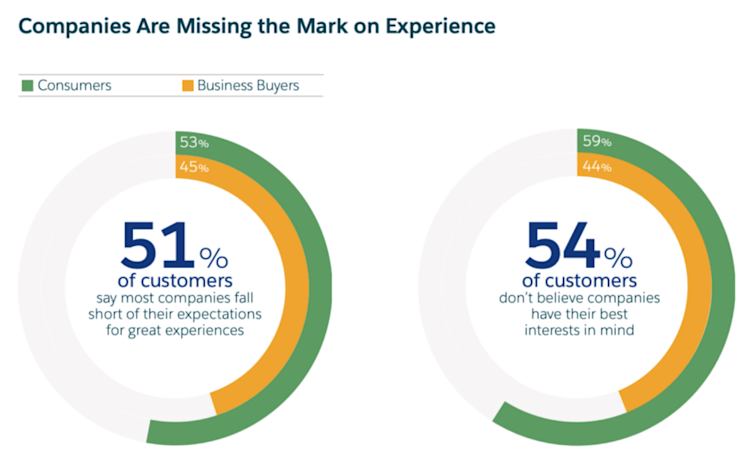
Showing your customers that you care is a vital part of creating a top-notch customer experience. And customer experience matters:
-
86% of buyers will pay more for a better customer experience.
-
80% of consumers say that their experience with a company is as important as its products and services.
-
65% of consumers say that making them feel like you care is the key to turning them into advocates. (This is especially important if you plan to ask for testimonials down the line.)
What does creating that caring customer experience look like in action?
Passive income coach and entrepreneur Rachael Taylor does a great job welcoming subscribers to her email list, “The Creative Rachael”.
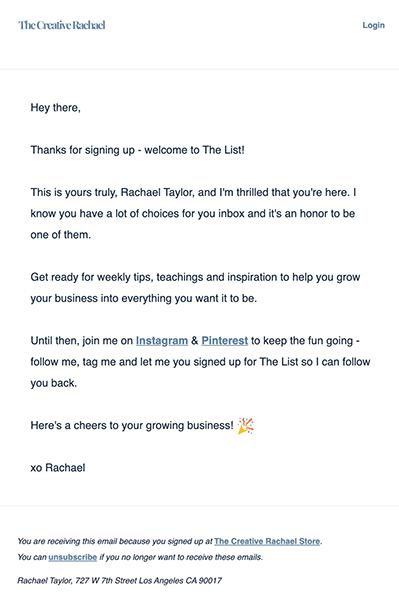
Rachael’s welcome email:
-
Thanks readers for subscribing and lets them know how much it means to her.
-
Acknowledges that having a place in her customers’ inboxes is something special (and explains why it’ll be worthwhile for them).
-
Tells them what kind of valuable content she plans to share.
Rachael also includes a call-to-action (CTA) to join her on social media, allowing subscribers to connect with her right away.
If you have an online community, making new subscribers feel welcome might be a bit more literal. In her welcome email, blogger and online educator Becky van Dijk invites new subscribers to join her Facebook group, Women’s Blogging Collective Facebook Group.
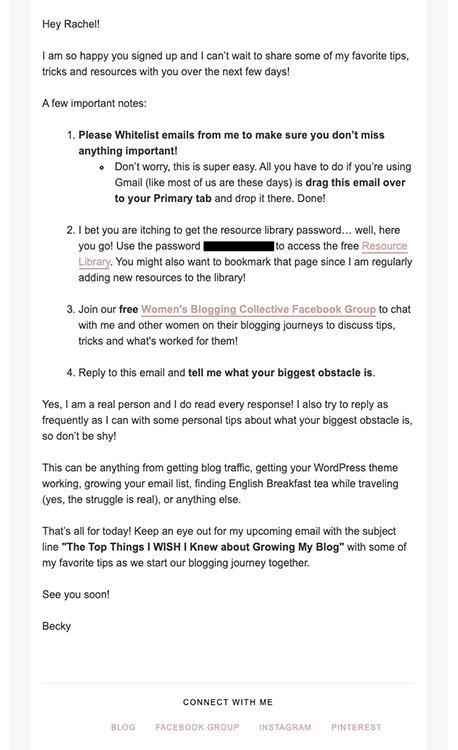
Becky sells online courses that help her fellow creators grow their blogs and businesses. Her private Facebook group is a major perk of joining her email list and gives new subscribers a sneak peek of the inside knowledge she brings to her products.
The bottom line: Whether you have an online community or not, use your welcome email to tell your subscribers that you appreciate and care about them.
3. Introduce yourself
Your welcome message is also a great place to tell new subscribers who you are. Who did they just sign up to hear from, and why should they open your emails moving forward?
Take a look at this welcome email from Khe Hy, founder of The $10K Institute and the Rad Reads newsletter:
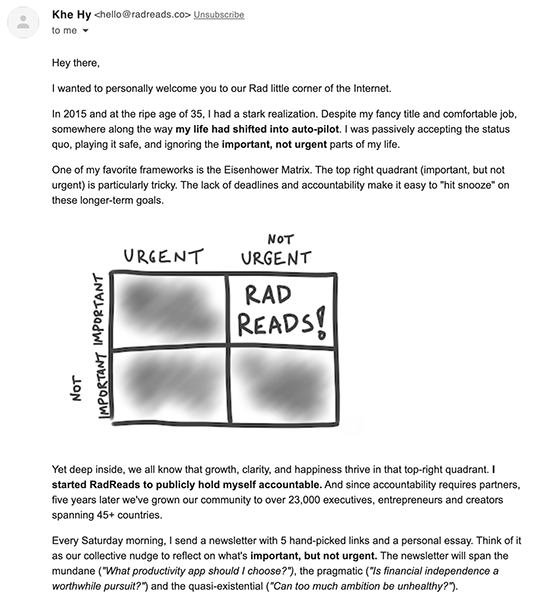
Khe gets personal, sharing the emotional journey that inspired him to launch his newsletter. New subscribers get to know Khe on a deeper level, and that helps him build trust and connect with his readers from the very beginning of their relationship.
That connection can play a significant role in growing your business. Customers who feel an emotional connection with a brand:
-
Have a 306% higher lifetime value.
-
Stay with the brand for longer (5.1 years vs. 3.4 years).
-
Recommend the brand at a much higher rate (71% vs. 45%).
And as a creator or solopreneur, you are your brand. Your expertise, personality, and unique outlook are all part of what makes you stand out from your competition.
Author, speaker, and podcasting pro Jay Acunzo opens his welcome email by introducing himself — and his newsletter persona — to subscribers.
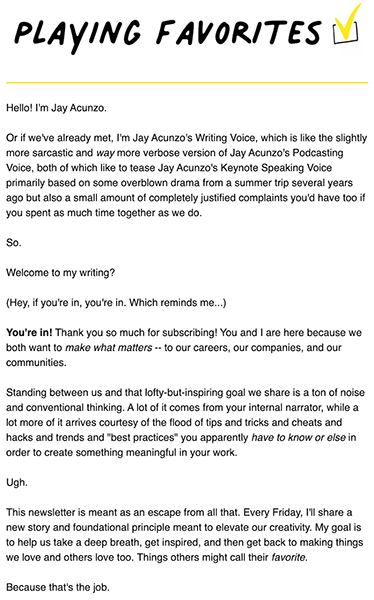
After introducing himself (and his writing voice), Jay shares his mission statement: To make what matters, and to inspire other creators to do the same.
(Learn how Jay uses Podia to help his fellow creators make what matters in this case study.)
Your mission statement is the “why” behind your business. In the words of renowned author and motivational speaker Simon Sinek, the “why” is “a purpose, cause, or belief. It’s the very reason your organization exists”.
56% of customers stay loyal to brands that “get them,” and 89% stay loyal to brands who share their values. When your “why” resonates with your audience, that connection we talked about earlier becomes even stronger, and you have loyal customers for the long haul.
Now, let’s move on from the introductions and into setting your readers up for success.
4. Set expectations and share next steps
Your welcome email should also let subscribers know what to expect from your newsletter. How often will you show up in their inboxes? What kind of content will you send them?
Setting expectations and onboarding new subscribers is especially important if you’re sending out an email course.
An email course is a series of lessons on one core topic sent via a series of emails. Many creators offer free email courses to bring potential students into their marketing funnel.
When you send out a free email course, you give subscribers a preview of the value and results they’ll receive if they enroll in your paid courses.
For example, web design pro and entrepreneur John D. Saunders offers a free email course, “Web Design & Digital Marketing Secrets,” to new members of his email list. As soon as someone enrolls in the course, they receive this welcome email.
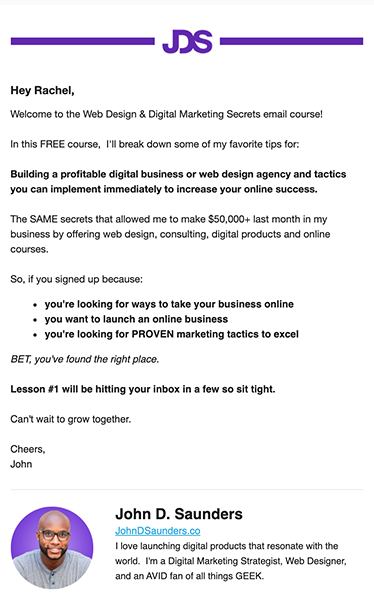
John gives subscribers an overview of the email course, including:
-
Why they should trust him ($50,000+ last month)
-
What they can expect to learn (how to build and market an online business)
-
When they’ll receive the first lesson (in just a few minutes)
Follow John’s example and use your welcome email to build excitement about what’s to come. He leaves just enough mystery to keep his students on the edge of their seats (and refreshing their inboxes) awaiting the first lesson.
A free email course is just one way to reward new subscribers for signing up. You can also send them a free digital download, which our next strategy is all about.
5. Reward subscribers for signing up
If you’ve ever shopped online, you’re probably familiar with the classic “Enter your email for 10% off your first order” signup form. Many ecommerce stores include a discount code or special offer in their welcome emails to encourage new customers to make their first purchase.
In the world of digital products, lead magnets are a more common incentive. A lead magnet is a free, valuable resource that new subscribers receive in exchange for signing up for your email list.
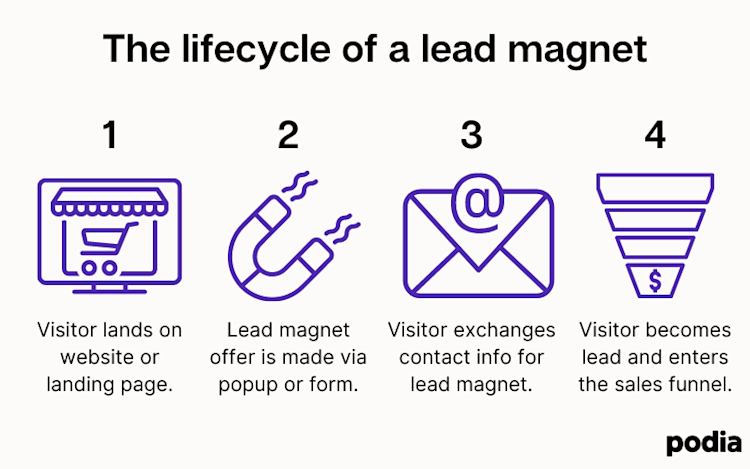
(To learn more about building your email list with lead magnets, check out this guide on how to create a lead magnet in 90 minutes or less.)
If your subscribers signed up in exchange for a lead magnet, it’s extra important that you send out your welcome email — lead magnet included — right away.
They’re expecting you to hold up your end of the bargain, and it’s a great opportunity to provide helpful free content to new contacts.
For example, business coach Natalie Sisson offers a free ebook, Get Paid to Be You, as a lead magnet on her website.
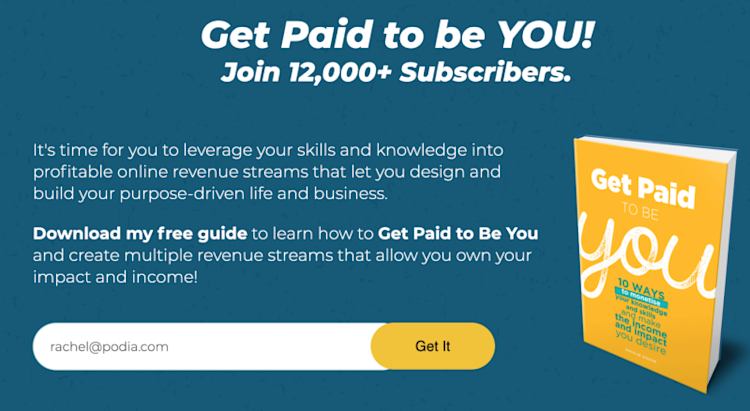
When someone signs up to receive the ebook, Natalie sends them a welcome email with a link to the digital download — and a whole lot more info.
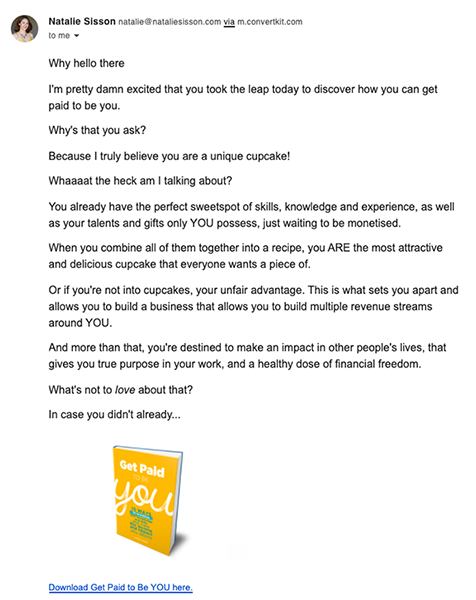
Not only does Natalie share the ebook, as promised, but she gives her subscribers a pep talk that rivals top motivational speakers. She makes them feel special, tells them how she can help them meet their goals, and even shares her own entrepreneurial journey.
Last but not least, Natalie follows our next (and final) tip — asking her subscribers to tell her more about themselves.
6. Get to know your subscribers
Sure, your welcome email is an excellent way to introduce new subscribers to you and your brand.
But it’s also the perfect time to do a little customer research and ask them about themselves.
Use your welcome email to learn more about your customers’ goals, pain points, and what inspired them to sign up.
Find out what they want to learn or achieve, then use that knowledge to create a more personalized experience, from the content you create to the products you recommend. 75% of consumers are more likely to purchase when they’re offered tailored product recommendations.
“Even sending a one-question survey can help gauge an interest, want, or need of your subscriber,” explains digital marketing expert Erik Harbison. “This can only help you determine a better approach for your content, sending cadence, and expectations.”
Through their digital products, blog, and podcast, Stacking the Bricks founders Amy Hoy and Alex Hillman help their fellow creators, “Ship more stuff. Make more money. Help more people”.
Here’s the welcome email subscribers receive when they sign up for the Stacking the Bricks newsletter.
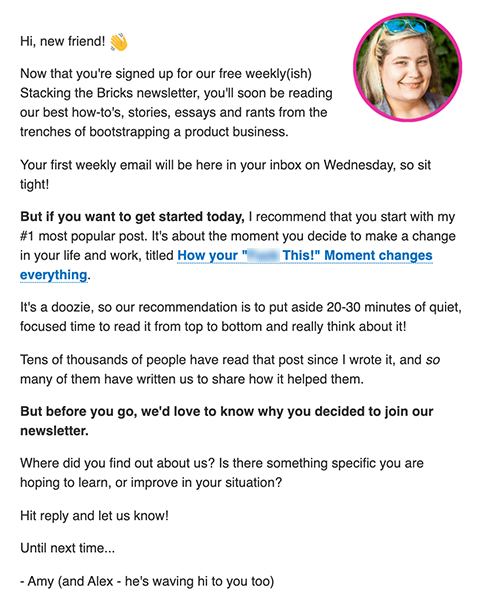
In the email, Amy asks readers to help her, help them: “Is there something specific you are hoping to learn, or improve in your situation?”
When people reply to the email and share their goals and struggles, Amy and Alex can use that information to create more content that helps their audience.
You can take your welcome email customer research a step further by including a segmentation survey.
Email segmentation is the process of dividing your email subscribers into smaller lists — a.k.a. segments — based on set criteria. Instead of sending the same email to your entire list, you can send more relevant email content to subscribers based on their segment.
And segmentation works.
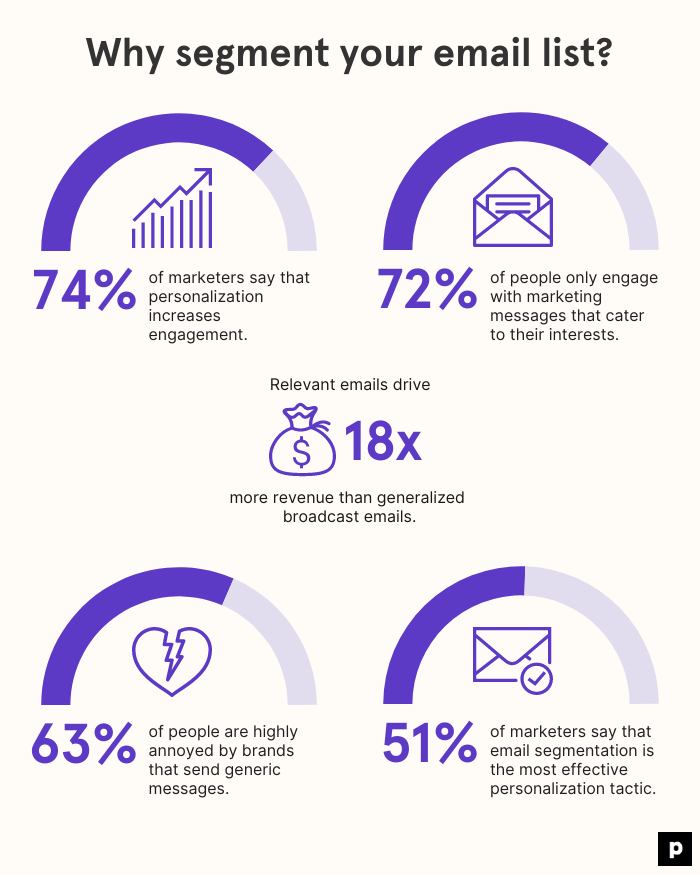
-
74% of marketers say personalization can increase engagement rates.
-
72% of people only engage with marketing messages that cater to their interests.
-
Relevant email content drives 18x more revenue than generalized broadcast emails.
-
63% of people are highly annoyed by brands that send generic messages.
-
51% of email marketers say that email list segmentation is the most effective personalization tactic.
In other words, when you segment your email list, you can send your audience the relevant content they crave, which means higher email engagement, fewer unsubscribes, and happier subscribers.
A segmentation survey helps you learn what type of content your subscribers want to receive in future emails, so you can segment your email list accordingly.
Python instructor Reuven Lerner sends out a weekly newsletter called “Better Developers”. In his welcome email, he tells subscribers what kind of content they’ll receive each week.
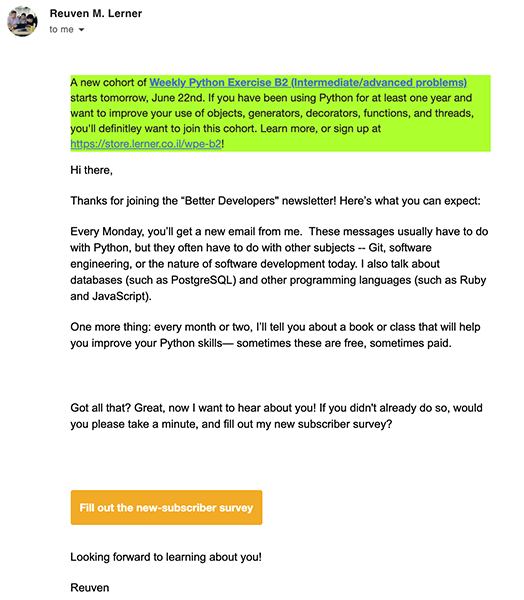
Reuven also includes a link to his new subscriber survey, asking subscribers to share more information about themselves, their experience, and their goals.
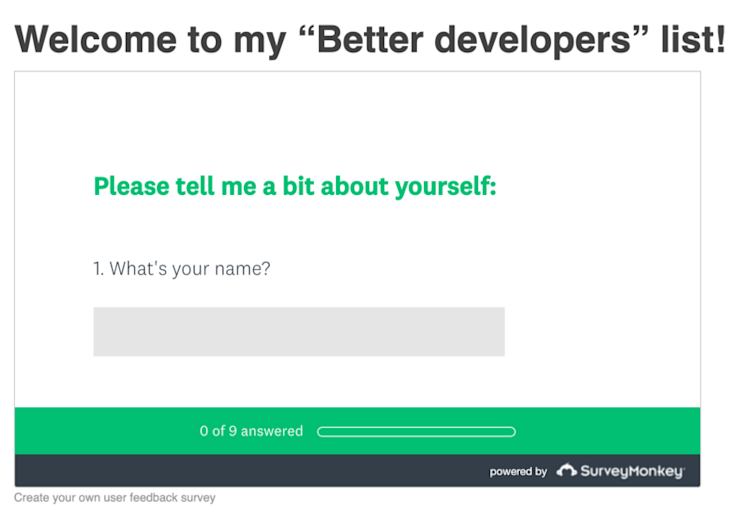
Reuven’s survey questions include:
-
How many years of Python experience do you have?
-
What sort of work do you do?
-
Does your company use online training, in-person training, or both?
-
What are the biggest frustrations you have with Python and other technologies you use?
By gathering this information about his subscribers, Reuven can offer them a tailored customer experience, including recommending the products that fit their skill levels, pain points, and goals.
Finally, don’t worry about annoying your audience when you ask for feedback. 91% of people believe that companies should fuel innovation by listening to buyers and customers.
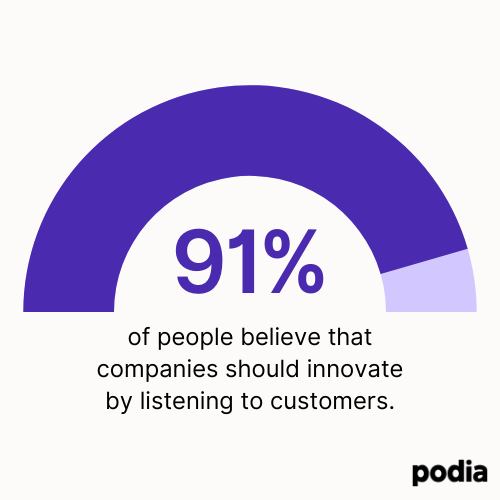
Your customers want to have a say in what you create, and they expect you to listen and act on their feedback.
Now, you’re almost ready to craft a stellar welcome email of your own. For even more tips on writing emails your subscribers will love, including a welcome email template you can customize for your business, check out this guide to starting a newsletter.
Before we wrap up, let’s walk through how simple it is to set up an automated welcome email with Podia.
How to send a welcome email with Podia
Podia’s all-in-one platform makes it easy for creators to create, sell, and promote digital products from a single dashboard, from hosting online courses to building email marketing campaigns.
To set up an automated welcome email with Podia, you need to create a conditional campaign. Conditional campaigns are email campaigns that subscribers enter when they meet a specific condition — like signing up for your newsletter.
Here’s how to create and send a welcome email with Podia.
(Want to follow along? Start your free 30-day trial of Podia today.)
First, go to the Email tab on your Podia dashboard. Then, click “Create” and select “New campaign”.

Give your campaign a name. This name will help you keep track of your campaigns, and only you will see it.
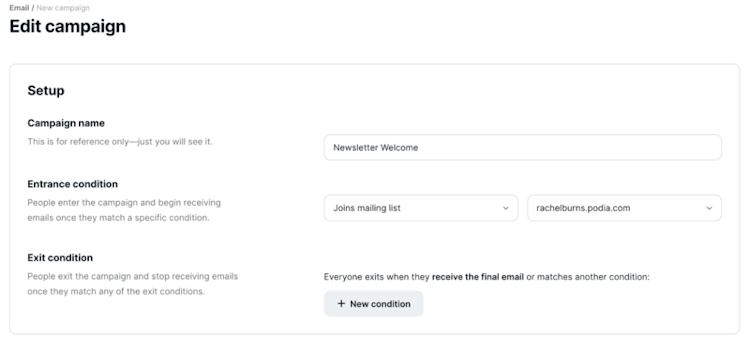
Set your campaign entrance condition. For your newsletter welcome email, you want people to enter the campaign when they sign up for your newsletter, so select “Joins mailing list”.
With this campaign automation, Podia will send out your welcome email when someone joins your email list.
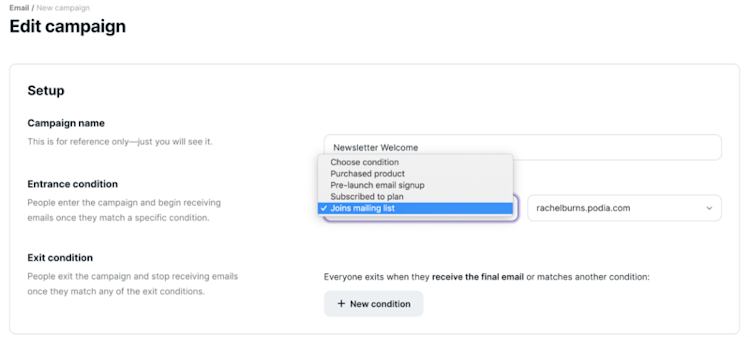
Next, it’s time to come up with a subject line and write your email copy using the strategies we covered earlier.
You can personalize your welcome email by adding a first name tag to the email body. (P.S.: Personalized emails deliver conversion rates six times higher than non-personalized emails.)
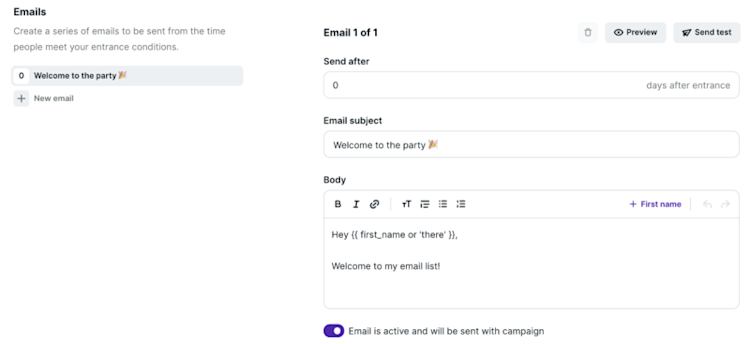
You can also choose how soon after subscribing you want your email to go out, preview your email, and send a test email to yourself.
In this example, we’re sending out a one-email campaign. To learn more about creating a workflow for automated email sequences, like a welcome email series, check out this help article.
Once you’re happy with your welcome email, make sure that “Email is active and will be sent with campaign” is toggled on. Then, click “Start campaign”.
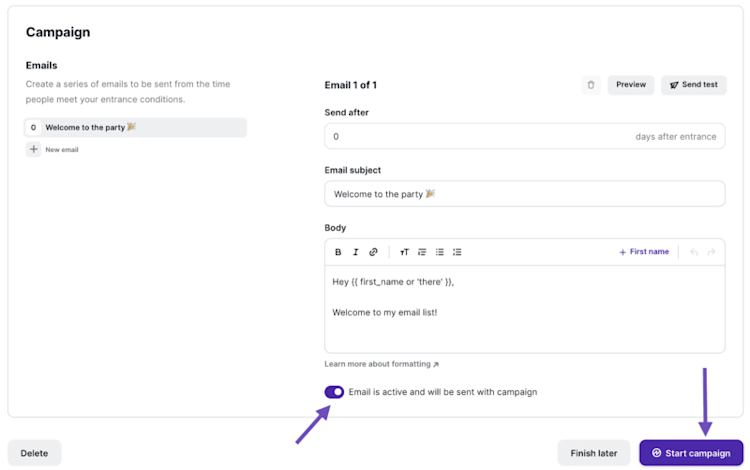
And just like that, your welcome email campaign is live!
New subscribers will automatically receive the email when they sign up for your newsletter. And when you use the tips we shared today, they’re sure to feel welcomed with open arms.
Create a welcome email that turns new subscribers into loyal fans
A great welcome email builds trust, boosts open rates, and helps you get to know your audience.
To recap, here are six welcome email best practices to create a top-notch campaign:
-
Write an attention-grabbing subject line that your subscribers can’t resist. Don’t be afraid to test different subject lines to see what resonates with your audience.
-
Make new subscribers feel welcome and appreciated with a heartfelt thank you.
-
Introduce yourself, your brand, and your mission. Use this opportunity to build credibility and connect with your new subscribers.
-
Set expectations, especially if your contacts are entering an email course. Let them know what comes next.
-
Reward subscribers with a free digital download. If they signed up for a lead magnet, make sure they get it right away.
-
Get to know your subscribers. Ask them about themselves, then use that info to create a more personalized experience (or even segment your list).
With all of these strategies in your email marketing arsenal, your welcome email is sure to be just the beginning. Keep getting to know your subscriber and sending them the email content they love, and you’ll be well on your way to a booming online business and loyal customers.
